The Silk Road was the great Tran Asian highway connecting China with far away Imperial Rome. Along it travelled precious cargoes of silk, gold, gems, ivory, plants, animals, art... Knowledge! (I advise you to read this report listening Kitaro “Silk Road")
|
 |
 |
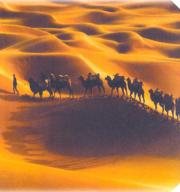 |
 |
 |
 |
 |
 |
Even in the XXI century there are camel caravans in Xinjiang
 |
 |
Xinjiang (or Sinkiang) is a world apart in China (well, Tibet and Inner Mongolia too, but the differences in Xinjiang are more patent). Most of its inhabitants, the Uygur, are muslims and belong to the Turcoman ethnical and linguistic group; they are related to the Uzbeks, Kyrgyz’s and Kazakhs. Xinjiang has the size of Spain, France, Germany and all the United Kingdom put together. Its Western side is surrounded by the high mountains of the Tien Shan range, and a significant part of its territory is dominated by the terrific desert Takla Makan (what literarily means in Uygur language: “you will go in but you will not go out”) with a surface similar to that of Italy, and inside its sand are buried many lost cities rich in treasures that were the leitmotiv of many Indiana Jones’ adventurers type in the XIX century to travel deeply into that inhospitable part of the world. The most famous Chinese travellers of the past, as Zhang Qian (the precursor of the Silk Road) and the monks Fa Xian and much later Xuan Zang (this one is my traveller hero together with the legendary Mullah Nasrudin) called at Kashi (or Kashgar) during their long and passionate journeys in search of knowledge, as well as the Chinese poets and travellers Li Bo and Du Fu, the wise Kumarajiva, and, of course, the most famous traveller of the world: Marco Polo. The goods leaving Chang’an (as was then known present Xian) travelled to the Eastern Mediterranean Sea though three ramifications. One of them traversed Xinjiang, and in Kashi one road crossed the Karakorum, another one the Pamir and the third one followed the Torugart Pass up in the Tien Shan. In Kashi you will admire the greatest Mosque in China, called Id Kah, in the centre of the town, which together to the annexed square has a capacity for 100.000 people. Its weekly bazaar (on Sundays) is one of the most exotic in Asia and one of the main tourist attractions.
|
|
| Favourite spots: |
 |
 |
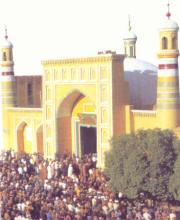 |
 |
 |
 |
 |
 |
Id Kah Mosque of Kashi, the greatest in China
 |
 |
Kashi played an important role when England and Russia were involved in a sort of “cold war” rivalry that the first denominated “Great Game” and the second “Tournament of Shadows” for their ascendancy over the territories in Central Asia. So important was that region that Tsar Alexander II sold in 1867 Alaska to the Americans for a little bit more than 7 million dollars to finance its defence. The English sent explorers/spies to that area of such category as Alexander Burnes, Moorcroft, Curzon, or Younghusband (who later would invade Tibet), while the Russians dispatched Lithuanian polyglot Jan Vitkevich, and the Polish Bronislav Gromchevsky, expert in Kashi. The Great Game ended shortly after the defeat of Russia before Japan in the 1904-05 war, and both powers signed an entente. Tibet and Xinjiang were awarded to China. Turkestan entered in the Russian sphere. Afghanistan was granted to England, and Persia was shared between the two powers. Everybody was happy (except the natives).
|
|
| What's really great: |
 |
 |
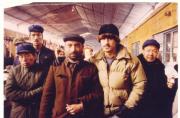 |
 |
 |
 |
 |
 |
This friend from Urumqi helped me to penetrate in the forbidden Kashi
 |
 |
At the time of this picture I was in Urumqi planning to penetrate Kashi without being noticed in a time when it was banned to the foreigners. The man in the picture helped me to buy the Uygur cap (I am the one with the green anorak). I was then travelling with an English companion, but she could not join me because of her gaudy external appearance. During that journey in an awful old bus I made friendship with a woman and, when in a control to board the bus a policeman requested the documents to the passengers who aroused his suspicious, I held the arm of my improvised friend and said to her in Chinese before him: “Soba, soba!” (Let’s go, let’s go!), and taking me for a local I was not demanded my passport. Everybody helped me, especially the Uygur, who took me for a kind of Ibn Batuta. After a five days and four night’s journey I arrived to Kashi, although the next day I was controlled by the Chinese police while walking in the camel market and sent back to Urumqi. But it was worth!
|
|
| Sights: |
 |
 |
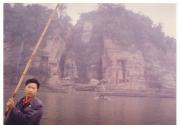 |
 |
 |
 |
 |
 |
Leshan Buddha, the biggest in the world (71 metres tall)
 |
 |
China is a fascinating country with an astonishing beauty, history, culture, ancient amazing sciences, arts, calligraphy, philosophy and wisdom. Even one year is not enough to capture all its facets, but if you do not have this time, then, at least you should not miss the loveliest and most romantic city in China: Guilin (if I would believe in reincarnation, next time I would like to be born in China). Another interesting place is Chengdu with its nearby tourists’ attractions. From that town of Sichuan you have many fantastic choices: to visit the Panda Bears in its natural habitat, to climb the gorgeous and poets inspiring Emei Shan (Shan means Mountain in Chinese), travelling to the Leshan Buddha carved into a cliff, etc. Chengdu Sam’s Guesthouse, in the centre of the town, is a must for every backpacker. He will help you in everything, free transport to the airport, excursions, advice, visa to Tibet and tickets, etc. Sichuan has probably the best kitchen in China, but is hot!
|
|
| Accommodations: |
 |
 |
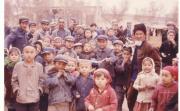 |
 |
 |
 |
 |
 |
Uygur people in Kashi are very curious about the foreigners
 |
 |
During the “Great Game/Tournament of Shadows” times, England and Russia opened two Consulates in Kashgar (in fact they were centres of espionage). When the two powers agreed some years later to concede to China the “right” to absorb “Kashgaria” within its dominions, they dismantled their “Consulates”.
Today, the ex Russian Consulate has been transformed in the SEMAN hotel, very nice and not expensive at all (I stayed there during my last two visits to Kashi). And the ex British Consulate is now the CHINI BAGH hotel.
Both hotels are centrally located and offer good Chinese and Uighur food.
There are cheaper accommodations for the broken traveller, but the privilege of staying in these two historical places compensates for the difference of price.
|
|
| Nightlife: |
 |
 |
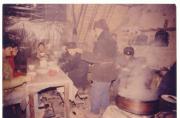 |
 |
 |
 |
 |
 |
We are eating in a Uygur caravanserai in Turpan
 |
 |
A good alternative to eat in the hotels or in big restaurants is to stroll around the narrow streets of Kashi, near the Great Mosque, and eat in the stalls the typical kebabs with aromatic tea and fruits (watermelons in Kashi are enormous and delicious, especially those brought from the town of Hami). To drink I advise you the world famous Chinese beer TSINGTAO, which has a German formula! Beer in Chinese is “PI JOU” (the Kaiser Wilhelm II, after some incidents where a Chinese Secret Society killed two German christian missionaries in Shandong Peninsula, forced to the Chinese Government to sign a 99 years lease over the Jiaozhou Bay and the town of Tsingtao, also known as Qingdao). You should try the Chinese strong wine or rather sweet liquor (tasting like the Georgian wines), made on fermented rice, which is more enjoyable than Japanese sake. There is a popular and delicious canned drink called in English “Coconut Drink”, made in the lovely Island of Hainan.
|
|
| Hangouts: |
 |
 |
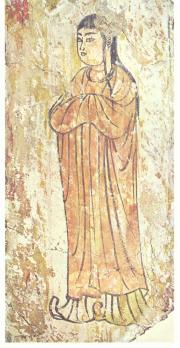 |
 |
 |
 |
 |
 |
“Workshipper”, fresco found in a Nestorian temple in Xinjiang (today in Berlin!)
 |
 |
Nestorius, the Patriarch of Constantinople, in the V century, preached an unorthodox theory about the nature of Jesus Christ that was condemned in the Ecclesiastical Council of Ephesus. Then, his followers, from the VII to the XIV centuries, took the way to the East propagating Nestorius teachings along the Byzantine Empire and followed the Silk Road. Its missionaries reached Persia, Central Asia, India, China, Mongolia, and probably Japan before the arrival of the Spanish Jesuit Francis Xavier. In Central Asia they even had a Bishop in Samarkand and another one in Kashgar. In 1885 Russians archaeologists discovered an ancient Nestorian cemetery in Xinjiang including frescoes and old manuscripts that were sent to the Hermitage Museum, Saint Petersburg. Today there are still many Nestorians (also known as Assyrians or Chaldeans) in Iraq, Iran, India, and in some Western countries. During WWI a third of the Nestorians existing in the world were massacred by Turks and Kurds.
|
|
| Restaurants: |
 |
 |
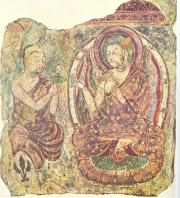 |
 |
 |
 |
 |
 |
Xinjiang fresco “Buddha and preaching Monk” (today in Berlin!)
 |
 |
One of the most didactic excursions that one can do in Xinjiang is to the caves with the rests of fantastic frescoes painted in the walls by Buddhist monks along the Silk Road that the Westerners did not have time to remove. The Europeans stripped many of these frescoes spoiling sometimes more than what they stole from the caves. Some of the perpetrators of these pilferages were the Swedish explorer Sven Hedin, German Albert von Le Coq (he was well educated and spoke Chinese), French Paul Pelliot, American Langdon Warner, and the Hungarian born Aureil Stein, nationalized British. Today there are more frescoes in the Indische Kunstabteilung of the Staatliche Museen in Berlin, or in Paris, in Saint Petersburg, in Tokyo, in London, in USA, Korea, and in private collections of Florence, than in Sinkiang. The most fabulous frescoes of all are those of the Mogao grottoes, near Dunhuang, in Gansu, but those of Bezeklik, near Turpan (called One Thousand Buddha’s) are also excellent.
|
|
| Other recommendations: |
 |
 |
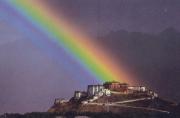 |
 |
 |
 |
 |
 |
Magnificent Potala Palace, in Lhasa
 |
 |
While in Xinjiang you should try to travel to Tibet as well. You need a Tibetan Tourist Permit (Sam from Chengdu will help you). There are daily flights from Chengdu to Lhasa. The flight from Kathmandu to Lhasa is more spectacular because the plane over fly the Everest. In Lhasa there is only one area to stay for a traveller, with plenty of cheap good hostels (like the Snowland): Barkhor, or the Tibetan quarter, where is situated the spiritual heart of Lhasa: Jokhang. Potala Palace is, of course, the visit “numero uno” in that town. The Sakya monastery, at 130 kilometres southwest of Shigatse, where the tourists are few and far between, was one of the largest in Tibet before the Cultural Revolution. It has a colossal collection of highly valuable pieces of art, and is called the second Dunhuang. It is shaped like a lying elephant. Sakya (Grey Soil) is one of the four Tibetan Buddhist Schools. The others are: Kagyu (Local Lineage), Nyingma (The Ancient Ones), and Gelug (Way of Virtue).
|
|
Published on Monday August 8th, 2005
|
|
 Publish on Facebook
Publish on Facebook
|
Sat, Jun 02 2007 - 06:07 AM
 by kwongmei
| Very informative and great pictures especially the one with rainboat on Potala Palace |
Tue, Nov 22 2005 - 09:11 PM
 by alemala by alemala
Great report, with a very good historic background and beautiful pictures.
Ale |
Sun, Nov 06 2005 - 11:42 AM
 by vbx000 by vbx000
| Incredible report! It was a mixture of all of the research (summed up) I had to do for my 12 page paper about the region + your own personal experience. Incredible. Absolutely great. I love the pictures too. I didn't get to go to Kashi or Kashgar but visited Urumqi and Turpan with my study group. |
Sun, Oct 16 2005 - 01:59 AM
 by joe_schmidt by joe_schmidt
Moin!
This is a very great trip report because of its additional historical informations. BTW., you can order tsingtao beer in many chinese restaurants in germany! :-)
Joe |
Wed, Aug 24 2005 - 09:24 AM
 by mistybleu by mistybleu
Jorge,
This is a great report, really enjoyed reading it.
Also the picture of Potala Palace is incredible.
Regards
Misty |
Thu, Aug 11 2005 - 07:54 AM
 by magsalex by magsalex
| Wow- an amazing adventure - as travel should be! |
Tue, Aug 09 2005 - 04:59 PM
 by bootlegga by bootlegga
Tue, Aug 09 2005 - 07:04 AM
 by rangutan by rangutan
| Another brilliant report. I like the idea of reading a report with the correct music, perhaps an additional feature at GLOBO one day? |
Mon, Aug 08 2005 - 09:43 PM
 by ravinderkumarsi by ravinderkumarsi
Mon, Aug 08 2005 - 05:26 PM
 by eirekay by eirekay
Incredible - as always!
Eire |
| Information: |
| Login if you are a member, or sign up for a free membership to rate this report and to earn globo points! |
|
| Greece |
|
|
 |
| Greenland |
|
|
 |
| India |
|
|
|
|
 |
| Iraq |
|
|
 |
| Italy |
|
|
 |
| Japan |
|
|
 |
| Korea, North |
|
|
 |
| Liberia |
|
|
 |
| Maldives |
|
|
 |
| Mauritius |
|
|
 |
| Micronesia, Federated States of |
|
|
 |
| Nepal |
|
|
 |
| Papua New Guinea |
|
|
 |
| Peru |
|
|
|

|
